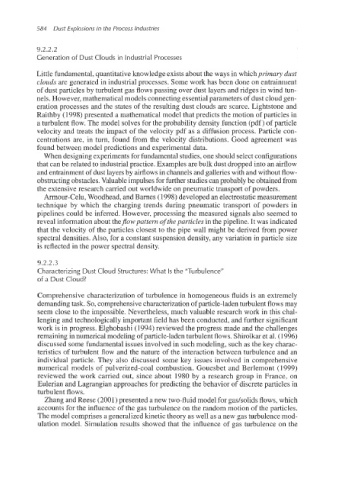Page 617 - Dust Explosions in the Process Industries
P. 617
584 Dust Explosions in the Process Industries
9.2.2.2
Generation of Dust Clouds in Industrial Processes
Little fundamental, quantitativeknowledge exists about the ways in which primary dust
clouds are generated in industrial processes. Some work has been done on entrainment
of dust particles by turbulent gas flows passing over dust layers and ridges in wind tun-
nels. However, mathematicalmodels connectingessentialparameters of dust cloud gen-
eration processes and the states of the resulting dust clouds are scarce. Lightstone and
Raithby (1998) presented a mathematical model that predicts the motion of particles in
a turbulent flow. The model solves for the probability density function (pdf) of particle
velocity and treats the impact of the velocity pdf as a diffusion process. Particle con-
centrations arc, in turn, found from the velocity distributions. Good agreement was
found between model predictions and experimental data.
When designing experiments for fundamental studies, one should select configurations
that can be related to industrial practice. Examples are bulk dust dropped into an airflow
and entrainmentof dust layers by airflows in channels and galleries with and without flow-
obstructingobstacles.Valuable impulses for further studies can probably be obtainedfrom
the extensive research carried out worldwide on pneumatic transport of powders.
Armour-Celu,Woodhead, and Barnes (1998) developed an electrostaticmeasurement
technique by which the charging trends during pneumatic transport of powders in
pipelines could be inferred. However, processing the measured signals also seemed to
reveal information about thejow pattern of the particles in the pipeline. It was indicated
that the velocity of the particles closest to the pipe wall might be derived from power
spectral densities. Also, for a constant suspension density, any variation in particle size
is reflected in the power spectral density.
9.2.2.3
Characterizing Dust Cloud Structures: What Is the "Turbulence"
of a Dust Cloud?
Comprehensive characterization of turbulence in homogeneous fluids is an extremely
demandingtask. So, comprehensivecharacterizationof particle-ladenturbulent flows may
seem close to the impossible. Nevertheless, much valuable research work in this chal-
lenging and technologically important field has been conducted, and further significant
work is in progress. Elghobashi (1994) reviewed the progress made and the challenges
remaining in numerical modeling of particle-laden turbulent flows. Shirolkar et al. (1996)
discussed some fundamental issues involved in such modeling, such as the key charac-
teristics of turbulent flow and the nature of the interaction between turbulence and an
individual particle. They also discussed some key issues involved in comprehensive
numerical models of pulverized-coal combustion. Gouesbet and Berlemont (1 999)
reviewed the work carried out, since about 1980 by a research group in France, on
Eulerian and Lagrangian approaches for predicting the behavior of discrete particles in
turbulent flows.
Zhang and Reese (2001)presented a new two-fluid model for gasholids flows, which
accounts for the influence of the gas turbulence on the random motion of the particles.
The model comprises a generalizedkinetic theory as well as a new gas turbulencemod-
ulation model. Simulation results showed that the influence of gas turbulence on the

